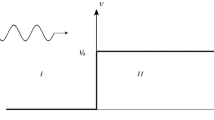Abstract
Using the discrete symmetries of the Klein—Gordon, Dirac, and Schrödinger wave equations, we obtain from one solution, considered as a function of the quantum numbers and the parameters of the potentials, three other solution. Taken together, these solutions form two complete sets of solutions of the wave equation. The coefficients of the linear relations between the functions of these sets — the connection coefficients — are related in a simple manner to the wave transmission and reflection amplitudes. By virtue of the discrete symmetries of the wave equation, the connection coefficients satisfy certain symmetry relations. We show that in a number of simple cases, the behavior of the wave function near the center of formation of an additional wave determines the amplitude of the wave that is formed at infinity.
Similar content being viewed by others
References
Willard Miller (Jr.),Symmetry and Separation of Variables, Addison-Wesley (1977).
I. A. Malkin and V. I. Man'ko,Dynamical Symmetries and Coherent States of Quantum Systems [in Russian], Nauka, Moscow (1979).
V. I. Fushchich and A. G. Nikishin,Symmetry of the Equations of Quantum Mechanics [in Russian], Nauka, Moscow (1990).
A. I. Nikitov,Tr. Fiz. Inst. Akad. Nauk,111 (1979).
A. A. Grib, S. G. Mamaev, and V. M. Mostepanenko,Vacuum Quantum Effects in Strong Fields [in Russian], Énergoizdat, Moscow (1988).
L. D. Landau and E. M. Lifshitz,Quantum Mechanics: Nonrelativistic Theory, 3rd ed., Pergamon Press, Oxford (1977).
A. I. Akhiezer and V. B. Berestetskii,Quantum Electrodynamics, Interscience, New York (1965).
A. Messiah,Quantum Mechanics, Vol. II, North-Holland, Amsterdam (1965).
A. I. Nikishov,Yad. Fiz.,46, 163 (1987).
S. Flügge,Practical Quantum Mechanics, Vols. 1 and 2, (Die Grundlehren der mathematischen Wissenschaften in Einzeldarstellungen, Vols. 177, 178), Springer-Verlag, Berlin (1971).
M. Abramowitz and I. A. Stegun,Handbook of Mathematical Functions with Formulas, Graphs, and Mathematical Tables, Dover (1964).
E. T. Whittaker and G. N. Watson,A Course of Modern Analysis, Cambridge (1965).
Y. Luke,Mathematical Functions and Their Approximations, Academic Press, New York (1975).
J. C. P. Miller,Tables of Weber Parabolic Cylinder Function, HMSO, London (1955).
M. V. Berry,Proc. R. Soc. London, Ser. A,422, 7 (1989).
A. I. Nikishov and V. I. Ritus,Teor. Mat. Fiz.,92, 24 (1992).
A. Érdelyi et al. (eds.),Higher Transcendental Functions, (California Institute of Technology H. Bateman M.S. Project), Vol. 1, McGraw Hill, New York (1953).
Additional information
P. N. Lebedev Physics Institute, Russian Academy of Sciences. Translated from Teoreticheskaya i Matematicheskaya Fizika, Vol. 98, No. 1, pp. 60–79, January, 1994.
Rights and permissions
About this article
Cite this article
Nikishov, A.I. Discrete symmetries in quantum scattering. Theor Math Phys 98, 42–54 (1994). https://doi.org/10.1007/BF01015123
Received:
Issue Date:
DOI: https://doi.org/10.1007/BF01015123



